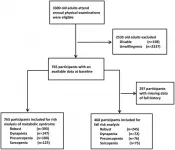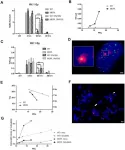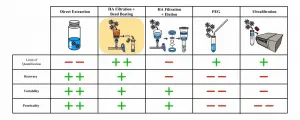(Press-News.org) COLUMBUS, Ohio - As psychedelics gain ground as a potential therapy for mental health disorders, there remains a pressing concern that patients in clinical trials may have adverse effects to the drugs.
New research identifies personality traits that have been associated with positive and negative experiences on psychedelics in previous studies, information that could help predict how future clinical trial participants will respond to the drugs.
The findings suggest that people more open to new experiences and willing to surrender to the unknown may be best positioned to have a positive experience on psychedelics, and individuals who tend to be preoccupied or apprehensive could be more likely to have a negative, or challenging, experience.
These predictions could be used by scientists to help hesitant clinical trial patients feel more open to the potential therapy, possibly by offering lower doses as a starting point, researchers say - though such a concept remains speculative.
"The findings point to interesting testable things we can look at in future research," said Alan Davis, assistant professor of social work at The Ohio State University and senior author of the review. "It might be plausible to use threshold doses that are smaller than those used in a trial as a first exposure so people have less anxiety, experience the benefit and, from that, go into a higher dose later."
The study is published online in the journal ACS Pharmacology & Translational Science.
To arrive at these predictions, the researchers reviewed 14 published clinical trials and other types of studies conducted in recent years that documented participants' personality traits or states of mind and their associations with a positive or negative experience on psychedelics.
"It's been an open question so far in psychedelic science: How can we predict how people will react? We thought this review would be a good opportunity to develop a narrative of what the consensus is so far," said study first author Jacob Aday, a PhD candidate in psychology at Central Michigan University who collaborates with Davis.
Preliminary evidence has suggested that psychedelics may be effective in treating mood, anxiety, trauma-based and substance use disorders.
"Psychedelics might broadly apply to a whole range of different psychiatric problems, and in part that might be because they're directly affecting neurotransmission and the brain's ability to communicate in new ways that involve different parts of the brain," Davis said. "But there is still a lot to unpack about exactly how this all works and why it may be effective."
Of the studies reviewed, 10 tested psilocybin (commonly known as magic mushrooms) as a therapy, two involved LSD, one used a hallucinogenic brew called ayahuasca and one examined psychedelic use in general.
Experiences on psychedelics vary in intensity and tend to comprise three categories: a mystical, insightful or challenging experience. A mystical experience can feel like a spiritual connection to the divine, an insightful experience increases people's awareness and understanding about themselves, and a challenging experience relates to emotional and physical reactions such as anxiety or increased arousal.
The review suggests that people who are high in the traits of openness, acceptance and absorption - the tendency to immerse oneself into imaginative experiences - and in a psychological state of surrendering to whatever may transpire are more likely to have positive psychedelic experiences.
A state of surrender, in particular, stood out for its association with a lower chance for acute dread and a higher likelihood of a mystical experience and what is known as "ego dissolution," when one's sense of self gives way to a closer connection to other people and the broader world.
In contrast, people who are low in those traits or who are in preoccupied, apprehensive or confused states are considered more likely to experience adverse reactions.
"There was also tentative evidence that increased experience with psychedelics and increased age were associated with slightly less intense effects with the drugs," Aday said. "And there weren't any differences according to sex. Men and women responded similarly."
Three studies had identified potential neurological markers that could help predict research participant reactions to psychedelics, but the cost of collecting brain scans to screen trial candidates made them less practical predictors than psychological traits, Aday said.
Davis has already considered potential reactions to psychedelics for a psilocybin trial he is planning for veterans who have post-traumatic stress disorder.
"People who have experienced trauma are not very high in surrender, because they are anxious all the time about their past traumatic experiences," he said. "A possibility to explore is starting with a low or moderate dose prior to giving the full therapeutic dose, which might help them increase in surrender. We've designed the study this way, thinking that might be helpful."
INFORMATION:
Study co-authors include Cayla Mitzkovitz, Emily Bloesch and Christopher Davoli of Central Michigan University.
Contacts: Alan Davis, Davis.5996@osu.edu; Jacob Aday, aday1js@cmich.edu
Written by Emily Caldwell, Caldwell.151@osu.edu
ITHACA, N.Y. - As the COVID-19 pandemic took hold in 2020, the list of things people could not do grew increasingly long.
But while going to the office, attending live events and gathering with large groups of friends became difficult or impossible, other activities grew in popularity - including online learning.
Drawing on records from DataCamp, an online platform tailored toward programming skills, a research team at Cornell University and Arizona State University used U.S. states' staggered adoption of nonessential business closures (NBC) to estimate their effects on the demand for online learning. The gradual closure of businesses across the U.S. gave the researchers a way to make a case for the cause and effect of NBC on increased engagement with the DataCamp ...
Aging-US published "Impact of adiposity on muscle function and clinical events among elders with dynapenia, presarcopenia and sarcopenia: a community-based cross-sectional study" which reported that low muscle function determined unfavorable clinical outcome than low muscle mass; nevertheless, comparison of detrimental parameters among dynapenia, presarcopenia and sarcopenia was sparse.
The authors hypothesized that adiposity is implicated in low muscle function related adverse events.
Associations of different obesity parameters, metabolic syndrome and fall among the groups were analyzed.
Among 765 participants, ...
The COVID-19 and Cancer Consortium (CCC19) published new findings in the Annals of Oncology, showing heightened mortality and racial disparities for patients with cancer diagnosed with SARS-CoV-2 infection.
After reviewing detailed information from almost 5,000 patients with active or past cancer and laboratory-confirmed COVID-19 diagnosis, CCC19 study authors found associations among laboratory measures, clinical factors -- including older age, hematological malignancy and recent chemotherapy - and poor clinical outcomes. Of the patients in the study with COVID-19 ...
Aging-US published "Functional analysis of POLD1 p.ser605del variant: the aging phenotype of MDPL syndrome is associated with an impaired DNA repair capacity" which reported that Mandibular hypoplasia, Deafness and Progeroid features with concomitant Lipodystrophy define a rare systemic disorder, named MDPL Syndrome, due to almost always a de novo variant in POLD1 gene, encoding the DNA polymerase δ.
A decline of cell growth, cellular senescence and a blockage of proliferation in G0/G1 phase complete the aged cellular picture.
Moreover, the rate of telomere shortening was greater in pathological ...
Researchers at the DZNE (Germany), at Massachusetts General Hospital (USA) and at the genomic medicine company Sangamo Therapeutics, Inc. tested a novel gene regulation approach to treat brain diseases such as Alzheimer's in laboratory studies. It leverages zinc finger proteins, which specifically bind to the DNA that codes for the protein Tau without altering it, thereby reducing Tau production in the brain and preventing nerve damage. The preclinical results, published in the journal Science Advances, could lay the foundation for new therapies.
The Tau ...
The efficacy of biosensors used in clinical tests depends critically on the surface of the device on which the biorecognition molecules are immobilized. This surface can be adjusted and sometimes controlled using self-assembled molecular monolayers as matrices. The monolayers are films made up of organic molecules that under the right conditions assemble spontaneously on metal surfaces via chemical bonds between the sulfur atoms and the metal.
A study conducted at the University of São Paulo's São Carlos Physics Institute (IFSC-USP) in Brazil compared the performances of two types of self-assembled ...
Myelodysplastic syndrome (MDS) is a disease of the stem cells in the bone marrow, which disturbs the maturing and differentiation of blood cells. Annually, some 200 Finns are diagnosed with MDS, which can develop into acute leukaemia. Globally, the incidence of MDS is 4 cases per 100,000 person years.
To diagnose MDS, a bone marrow sample is needed to also investigate genetic changes in bone marrow cells. The syndrome is classified into groups to determine the nature of the disorder in more detail.
In the study conducted at the University of Helsinki, microscopic images of MDS patients' bone marrow samples were examined utilising an image analysis technique based ...
Greenwood, SC (March 22, 2021) - A research team at the Greenwood Genetic Center (GGC) has identified the mechanism that causes movement disorders in patients with mutations in the NUS1 gene. Using both cellular and model organism studies, cholesterol accumulation was found to contribute to the symptoms of seizures, ataxia, and movement abnormalities. This breakthrough study on NUS1, a gene that has also been potentially linked to Parkinson's Disease, is reported in the current issue of Genetics in Medicine, the Journal of the American College of Medical Genetics and Genomics.
Chloe Murphy, 15, of Bluffton, SC began experiencing tremors at age three. Through the years she has also experienced seizures, atypical eye movements, learning delays, ...
Reston, VA--A new treatment for late-stage neuroendocrine tumors (NETs) has been found to be more effective and have fewer side effects than the current standard of care, according to research published in the March issue of The Journal of Nuclear Medicine. The novel peptide receptor radionuclide therapy holds promise to reduce mortality among NET patients and decrease the financial burden of their continual treatment.
NETs are a diverse group of tumors that originate from the neuroendocrine system, which is responsible for regulating hormones throughout the body. The number of people who are diagnosed with NETs is growing; the incidence of NETs increased 6.4-fold from 1973 to 2012. However, because they are rare, varied, ...
HOUSTON - (March 22, 2021) - There are many ways to test municipal wastewater for signs of the virus that causes COVID-19, but scientists in Houston have determined theirs is the best yet.
A study led by environmental engineer Lauren Stadler of Rice University's Brown School of Engineering with the aid of the City of Houston Health Department and Baylor College of Medicine compared five processes used by labs around the country to concentrate samples and find the virus in wastewater from six Houston plants.
The process employed at Rice and now Baylor, called "electronegative filtration with bead beating," proved the most sensitive to signs of the virus as well as the most cost-effective.
The study appears in the Elsevier journal Water Research.
There ...




